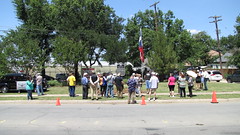Fairmount-Southside Historic District The Fairmount-Southside Historic District is a predominately residential area in the center of Fort Worth's Historic Southside. Located approximately two miles south of present-day downtown, the district is comprised of 22 separate additions containing more than 1,200 contributing residences, commercial buildings and other structures. It emcompasses nearly 375 acres in about 100 square blocks. Most residences were built as wood-framed single-family cottages, bungalows and two-story foursquare homes. Fort Worth was incorporated in 1873 in anticipation of the first railroad, which came through in 1876. Speculators bought and sold land they believed would turn the most profit if Fort Worth's economy was bolstered by the railroad. During the post-railroad boom, the city began to quickly expand south. Developers planned the additions that now comprise the Fairmount-Southside Historic District during the years 1883-1907. The largest was the Fairmount Addition, platted in 1890, which encompasses much of the western half of the district. When developed, the land on which the Fairmount-Southside Historic District now rests was on the southernmost edge of the city. The district grew rapidly in its formative years, as many middle-income workers moved to Fort Worth for various employment opportunities. Within the first two decades of the 20th Century, streetcar lines ran down major district thoroughfares, including College and Fairmount Avenues, carrying railroad employees, doctors, lawyers, salesmen and merchants to and from their homes built on the Southside to their areas of employment. Beginning with Queen Anne and ending in the Craftsman style, the homes built by the original residents now showcase the evolution of domestic architecture of early 20th Century suburban America. (2016) Marker is property of the State of Texas
Allen Street, Fort Worth, TX
Google Streetview
OpenStreetMap
Subjects
None identified yet. Subjects are curated by hand so please bear with us.


